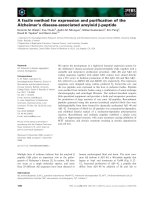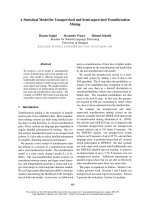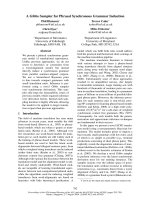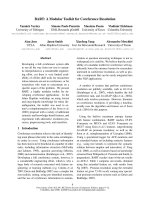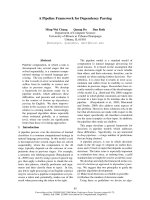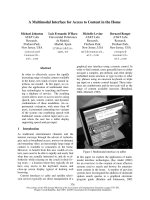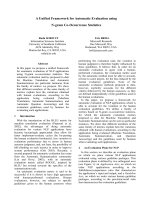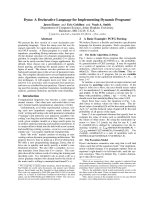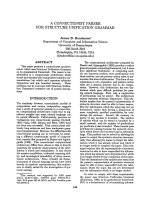Báo cáo khoa học: "A STOCHASTIC PROCESS FOR WORD FREQUENCY DISTRIBUTIONS" pot
Bạn đang xem bản rút gọn của tài liệu. Xem và tải ngay bản đầy đủ của tài liệu tại đây (657.31 KB, 8 trang )
A STOCHASTIC PROCESS FOR WORD FREQUENCY
DISTRIBUTIONS
Harald Baayen*
Maz-Planck-Institut fiir Psycholinguistik
Wundtlaan 1, NL-6525 XD Nijmegen
Internet:
ABSTRACT
A stochastic model based on insights of Man-
delbrot (1953) and Simon (1955) is discussed
against the background of new criteria of ade-
quacy that have become available recently as a
result of studies of the similarity relations be-
tween words as found in large computerized text
corpora.
FREQUENCY DISTRIBUTIONS
Various models for word frequency distributions
have been developed since Zipf (1935) applied
the zeta distribution to describe a wide range of
lexical data. Mandelbrot (1953, 1962)extended
Zipf's distribution 'law'
K
f, = ?x, (i)
where fi is the sample frequency of the
i th
type
in a ranking according to decreasing frequency,
with the parameter B,
K
f~ = B + i~ ' (2)
by means of which fits are obtained that are more
accurate with respect to the higher frequency
words. Simon (1955, 1960) developed a stochas-
tic process which has the Yule distribution
f, = AB(i, p + 1), (3)
with the parameter A and
B(i, p +
i) the Beta
function in (i, p + I), as its stationary solutions.
For i ~ oo, (3) can be written as
f~ ~ r(p + 1)i -(.+I)
,
in other words, (3) approximates Zipf's law with
respect to the lower frequency words, the tail of
*I am indebted to Kl~as van Ham, Richard
Gill,
Bert
Hoeks and Erlk Schils for stimulating discussions on the
statistical analysis
of
lexical similarity relations.
the distribution. Other models, such as Good
(1953), Waring-Herdan (Herdan 1960, Muller
1979) and Sichel (1975), have been put forward,
all of which have Zipf's law as some special or
limiting form. Unrelated to Zipf's law is the
lognormal hypothesis, advanced for word fre-
quency distributions by Carroll (1967, 1969),
which gives rise to reasonable fits and is widely
used in psycholinguistic research on word fre-
quency effects in mental processing.
A problem that immediately arises in the con-
text of the study of word frequency distribu-
tions concerns the fact that these distributions
have two important characteristics which they
share with other so-called large number of rare
events (LNRE) distributions (Orlov and Chi-
tashvili 1983, Chltashvili and Khmaladze 1989),
namely that on the one hand a huge number of
different word types appears, and that on the
other hand it is observed that while some events
have reasonably stable frequencies, others occur
only once, twice, etc. Crucially, these rare events
occupy a significant portion of the list of all
types observed. The presence of such large num-
bers of very low frequency types effects a signifi-
cant bias between the rank-probability distribu-
tion and the rank-frequency distributions lead-
ing to the contradiction of the common mean
of the law of large numbers, so that expressions
concerning frequencies cannot be taken to ap-
proximate expressions concerning probabilities.
The fact that for LNRE distributions the rank-
probability distributions cannot be reliably esti-
mated on the basis of rank-frequency distribu-
tions is one source of the lack of goodness-of-fit
often observed when various distribution 'laws'
are applied to empirical data. Better results are
obtained with Zipfian models when Orlov and
Chitashvili's (1983) extended generalized Zipf's
law is used.
A second problem which arises when the ap-
propriateness of the various lexical models is
271
considered, the central issue of the present dis-
cussion, concerns the similarity relations among
words in lexical distributions. These empirical
similarity relations, as observed for large corpora
of words, impose additional criteria on the ad-
equacy of models for word frequency distribu-
tions.
SIMILARITY RELATIONS
There is a growing consensus in psycholinguis-
tic research that word recognition depends not
only on properties of the target word (e.g. its
length and frequency), but also upon the number
and nature of its lexical competitors or neigh-
bors. The first to study similarity relations
among lexical competitors in the lexicon in re-
lation to lexical frequency were Landauer and
Streeter (1973). Let a
seighbor
be a word that
differs in exactly one phoneme (or letter) from
a given target string, and let the neighborhood
be the set of all neighbors, i.e. the set of all
words at Hamming distance 1 from the target.
Landauer and Streeter observed that (1) high-
frequency words have more neighbors than low-
frequency words (the neighborhood density ef-
fect), and that (2) high-frequency words have
higher-frequency neighbors than low-frequency
words (the neighborhood frequency effect). In
order to facilitate statistical analysis, it is con-
venient to restate the neighborhood frequency
effect as a correlation between the target's num-
ber of neighbors and the frequencies of these
neighbors, rather than as a relation between
the target's frequency and the frequencies of its
neighbors targets with many neighbors having
higher frequency neighbors, and hence a higher
mean neighborhood frequency .f,~ than targets
with few neighbors. In fact, both the neighbor-
hood density and the neighborhood frequency
effect are descriptions of a single property of
lexical space, namely that its dense similarity
regions are populated by the higher frequency
types. A crucial property of word frequency dis-
tributions is that the lexical similarity effects oc-
cur not only across but also within word lengths.
Figure 1A displays the rank-frequency distri-
bution of Dutch monomorphemic phonologically
represented stems, function words excluded, and
charts the lexical similarity effects of the subset
of words with length 4 by means of boxplots.
These show the mean (dotted line), the median,
the upper and lower quartiles, the most extreme
data points within 1.5 times the interquartile
range, and remaining outliers for the number of
neighbors (#n) against target frequency (neigh-
borhood density), and for the mean frequency of
the neighbors of a target (f,~) against the hum-
Table i: Spearman rank correlation analysis of
the neighborhood density and frequency effects
for empirical and theoretical words of length 4.
Dutch Mand. Mand Simon
dens.
freq.
r, 0.24 0.65 0.31
0.06 0.42 O. I0
~e
t 9.16 68.58 11.97
df
1340 6423 1348
rs 0.51 0.62 0.61
2 0.26 0.38 0.37
7" i
t 21.65 63.02 28.22
df 1340 6423 1348
ber of neighbors of the target (neighborhood fre-
quency), for targets grouped into frequency and
density classes respectively. Observe that the
rank-frequency distribution of monomorphemic
Dutch words does not show up as a straight
line in a double logarithmic plot, that there is
a small neighborhood density effect and a some-
what more pronounced neighborhood frequency
effect. A Spearman rank correlation analysis
reveals that the lexlcal similarity effects of fig-
ure 1A are statistically highly significant trends
(p <~ 0.001), even though the correlations them-
selves are quite weak (see table 1, column 1): in
the case of lexical density only 6% of the variance
is explained. 1
STOCHASTIC MODELLING
By themselves, models of the kind proposed
by Zipf, Herdan and Muller or Sichel, even
though they may yield reasonable fits to partic-
ular word frequency distributions, have no bear-
ing on the similarity relations in the lexicon.
The only model that is promising in this respect
is that of Mandelbrot (1953, 1962). Mandel-
brot derived his modification of Zipf's law (2)
on the basis of a Markovlan model for generat-
ing words as strings of letters, in combination
with some assumptions concerning the cost of
transmitting the words generated in some op-
timal code, giving a precise interpretation to
Zipf's 'law of abbreviation'. Miller (1057), wish-
ing to avoid a teleological explanation, showed
that the Zipf-Mandelbrot law can also be de-
rived under slightly different assumptions. Inter-
estingiy, Nusbaum (1985), on the basis of sim-
ulation results with a slightly different neighbor
definition, reports that the neighborhood density
and neighborhood frequency effects occur within
XNote that the larger value of r~ for the neighborhood
frequency eiTect is a direct consequence of the fact that
the frequencies of the neighbors of each target are a~-
eraged
before they enter into the calculations, masking
much of the variance.
272
lO t
10 a
10 ~
10 x
I0 °
~Tt
20
16
12
8
4
0
I
2000
I000
500
100
50
]l ]l ]I II l[ 0
FC 1
! !
12 456
~,e ~e3 ~vs 3~s xe, oe ea # items
o
"
i
DC
I I I | I I l I I
1
23456
10° lOt 102 lO! lOt ~li
J.o ~ox I,. ,o x.
#
itenm
A:
Dutch monomorphemic stems in the CELEX database, standardized at 1,00O,0OO. For the total
distribution, N = 224567, V = 4455. For strings of length 4,/V = 64854, V = 1342.
l0 t
55
10 a 10110 ~ "° . 443322
11
10° ~ ,
i 0
I0 ° I0 x 102 I0 ~
lO t
I0 ~
, , , , , FC 1
1 34567
:sso xs,41oo:svv :8v x~J s7 # itenm
I000
500
I00
50
I0
iilIlii
, , DC
1234567
3s4 'r .es e~x so. e.uoo~ # items
B: Simulated Dutch monomorphemic stems, as generated by a Markov process. For the total distribu-
tion, N = 224567, V = 58300. For strings of length 4, N = 74618, V 6425.
/, #n /.
104
35 I000 ~
•
I
"" . ! [II]ll
103 28
I00
21 50
I0 s
14
10
101 7
10° , i 0 FC 1 DC
345
I0° 10z 10s 103 104 3w
2s~
20,
~ss z~o
,.
xs~ #
items
xg~
~o 23~ ~ ~ov ~v a~ # items
C: Simulated Dutch monomorphemic stems, as generated by the Mandelbrot-Simon model (a = 0.01,
Vc = 2000). For the total distribution, N = 291944, V = 4848. For strings of length 4, N = 123317,
V = 1350.
Figure 1: Rank-frequency and lexical similarity characteristics of the empirical and two simulated
distributions of Dutch phonological stems. From left to right: double logarithmic plot of rank i versus
frequency fi, boxplot of frequency class FC (1:1;2:2-4;3:5-12;4:13-33;5:34-90;6:91-244;7:245+) versus
number of neighbors #n (length 4), and boxplot of density class DC ( 1:1-3;2:4-6;3:7-9;4:10-12;5:13-
15;6:16-19;7:20+) versus mean frequency of neighbors fn (length 4). (Note that not all axes are scaled
equally across the three distributions). N: number of tokens, V: number of types.
273
a given word length when the transition proba-
bilities are not uniformly distributed. Unfortu-
nately, he leaves unexplained why these effects
occur, and to what extent his simulation is a
realistic model of lexical items as used in real
speech.
In order to come to a more precise understand-
ing of the source and nature of the lexical simi-
larity effects in natural language we studied two
stochastic models by means of computer simu-
lations. We first discuss the Markovian model
figuring in Mandelbrot's derivation of (2).
Consider a first-order Markov process. Let
A = {0,1, ,k} be the set of phonemes of
the language, with 0 representing the terminat-
ing character space,
and
let T ~ : (P~j)i,jeA with
P00 = 0. If X,~ is the letter in the r, th position of
a string, we define P(Xo = i) = po~, i E A. Let
y be a finite string (/o,/1, ,/m-z) for m E N
and define X (m) := (Xo, XI, ,Xm-1), then
Pv := p(X(") = l~) = Po~01~0~l l~ _0~,_,.
(4)
The string types of varying length m, terminat-
ing with the space and without any intervening
space characters, constitute the words of the the-
oretical vocabulary
s,,, := {(io, i~, ,~,,_=,o):
ij E A \ O,j =O,I, ,m- 2, mE N}.
With N~ the token frequency of type y and
V the number of different types, the vec-
tor (N~,N~= , N~v) is multinomially dis-
tributed. Focussing on the neighborhood den-
sity effect, and defining the neighborhood of a
target string yt for fixed length rn as
Ct :=
~y
E
such
we have that the
of Yt equals
S,,, : 3!i e {0, 1, , m - 2}
that yl ¢ yt} ,
expected number of neighbors
E[V(Ct)] = ~ {1 - (1 - p~)N}, (5)
IIEC,
with N denoting the number of trials (i.e. the
number of tokens sampled). Note that when the
transition matrix 7 ) defines a uniform distribu-
tion (all pi# equal), we immediately have that
the expected neighborhood density for length rnl
is identical for all targets Yt, while for length
m~ > rnl the expected density will be less than
that at length ml, since p(,n=) < p(,m) given
(4). With E[Ny] = Np~, we find that the neigh-
borhood density effect does occur across word
lengths, even though the transition probabilities
are uniformly distributed.
In order to obtain a realistic, non-trivial the-
oretical word distribution comparable with the
empirical data of figure 1A, the transition matrix
7 ~ was constructed such that it generated a sub-
set of phonotactically legal (possible) monomor-
phematic strings of Dutch by conditioning con-
sonant CA in the string X~XjC~
on Xj
and the
segmental nature (C or V) of Xi, while vowels
were conditioned on the preceding segment only.
This procedure allowed us to differentiate be-
tween e.g. phonotactically legal word initial kn
and illegal word final k• sequences, at the same
time avoiding full conditioning on two preced-
ing segments, which, for four-letter words, would
come uncomfortably close to building the prob-
abilities of the individual words in the database
into the model.
The rank-frequency distribution of 58300
types and 224567 tokens (disregarding strings of
length 1) obtained by means of this (second or-
der) Markov process shows up in a double Iog-
arithrnic plot as roughly linear (figure IB). Al-
though the curve has the general Zipfian shape,
the deviations at head and tail are present by ne-
cessity in the light of Rouault (1978). A compar-
ison with figure 1A reveals that the large surplus
of very low frequency types is highly unsatisfac-
tory. The model (given the present transition
matrix) fails to replicate the high rate of use of
the relatively limited set of words of natural lan-
guage.
The lexlcal similarity effects as they emerge
for the simulated strings of length 4 are displayed
in the boxplots of figure lB. A very pronounced
neighborhood density effect is found, in combi-
nation with a subdued neighborhood frequency
effect (see table 1, column 2).
The appearance of the neighborhood density
effect within a fixed string length in the Marko-
vian scheme with non-uniformly distributed p~j
can be readily understood in the simple case
of the first order Markov model outlined above.
Since neighbors are obtained by substitution of
a single element of the phoneme inventory A,
two consecutive transitional probabilities of (4)
have to be replaced. For increasing target prob-
ability p~,, the constituting transition probabil-
ities Pij must increase, so that, especially for
non-trivial m, the neighbors y E Ct will gen-
erally be protected against low probabilities py.
Consequently, by (5), for fixed length m, higher
frequency words will have more neighbors than
lower frequency words for non-uniformly dis-
tributed transition probabilities.
The fact that the lexical similarity effects
emerge for target strings of the same length is
a strong point in favour of a Markovian source
274
for word frequency distributions. Unfortunately,
comparing the results of figure 1B with those
of figure 1A, it appears that the effects are of
the wrong order of magnitude: the neighborhood
density effect is far too strong, the neighborhood
frequency effect somewhat too weak. The source
of this distortion can be traced to the extremely
large number of types generated (6425) for a
number of tokens (74618) for which the empirical
data (64854 tokens) allow only 1342 types. This
large surplus of types gives rise to an inflated
neighborhood density effect, with the concomi-
tant effect that neighborhood frequency is scaled
down. Rather than attempting to address this
issue by changing the transition matrix by using
a more constrained but less realistic data set,
another option is explored here, namely the idea
to supplement the Markovian stochastic process
with a second stochastic process developed by
Simon (1955), by means of which the intensive
use can be modelled to which the word types of
natural language are put.
Consider the frequency distribution of e.g. a
corpus that is being compiled, and assume that
at some stage of compilation N word tokens have
been observed. Let n (Jr) be the number of word
types that have occurred exactly r times in these
first N words. If we allow for the possibilities
that both new types can be sampled, and old
types can be re-used, Simon's model in its sim-
plest form is obtained under the three assump-
tions that (1) the probability that the (N + 1)-st
word is a type that has appeared exactly r times
is proportional to r~ Iv), the summed token fre-
quencies of all types with token frequency r at
stage N, that (2) there is a constant probability
c~ that the (N-f 1)-st word represents a new type,
and that (3) all frequencies grow proportionaly
with N, so that
n~ (Iv+l) N + 1
g~' V = "-W for all r, lv.
Simon (1955) shows that the Yule-distribution
(3) follows from these assumptions. When the
third assumption is replaced by the assumptions
that word types are dropped with a probabil-
ity proportional to their token frequency, and
that old words are dropped at the same rate at
which new word types are introduced so that
the total number of tokens in the distribution is
a constant, the Yule-distribution is again found
to follow (Simon 1960).
By itself, this stochastic process has no ex-
planatory value with respect to the similarity
relations between words. It specifies use and re-
use of word types, without any reference to seg-
mental constituency or length. However, when a
Markovian process is fitted as a front end to Si-
mon's stochastic process, a hybrid model results
that has the desired properties, since the latter
process can be used to force the required high
intensity of use on the types of its input distri-
bution. The Markovian front end of the model
can be thought of as defining a probability dis-
tribution that reflects the ease with which words
can be pronounced by the human vocal tract,
an implementation of phonotaxis. The second
component of the model can be viewed as simu-
lating interfering factors pertaining to language
use. Extralinguistic factors codetermine the ex-
tent to which words are put to use, indepen-
dently of the slot occupied by these words in the
network of similarity relations, ~ and may effect
a substantial reduction of the lexlcal similarity
effects.
Qualitatively satisfying results were obtained
with this 'Mandelbrot-Simon' stochastic model,
using the transition matrix of figure IB for the
Markovlan front end and fixing Simon's birth
rate a at 0.01. s An additional parameter, Vc,
the critical number of types for which the switch
from the front end to what we will refer to as
the component of use is made, was fixed at 2000.
Figure 1C shows that both the general shape of
the rank-frequency curve in a double logarith-
mic grid, as well as the lexical similarity effects
(table 1, column 3) are highly similar to the em-
pirical observations (figure 1A). Moreover, the
overall number of types (4848) and the number
of types of length 4 (1350) closely approximate
the empirical numbers of types (4455 and 1342
respectively), and the same holds for the overall
numbers of tokens (291944 and 224567) respec-
tively. Only the number of tokens of length 4
is overestimated by a factor 2. Nevertheless, the
type-token ratio is far more balanced than in the
original Markovian scheme. Given that the tran-
sition matrix models only part of the phonotaxis
of Dutch, a perfect match between the theoret-
ical and empirical distributions is not to be ex-
pected.
The present results were obtained by imple-
menting Simon's stochastic model in a slightly
modified form, however. Simon's derivation of
the Yule-distribution builds on the assumption
that each r grows proportionaly with N, an as-
2For instance, the Dutch word kuip, 'barrel', is a low-
frequency type in the present-day language, due to the
fact that its denotatum has almost completely dropped
out of use. Nevertheless, it was a high-frequency word
in earlier centuries, to which the high frequency of the
surname ku~per bears witness.
~The new types entering the distribution at rate
were generated by means of the tr~nsitlon matrix of figure
113.
275
sumption that does not lend itself to implemen-
tation in a stochastic process. Without this as-
sumption, rank-frequency distributions are gen-
erated that depart significantly from the empir-
ical rank-frequency curve, the highest frequency
words attracting a very large proportion of all
tokens. By replacing Simon's assumptions 1 and
3 by the 'rule of usage' that
the probability that the (N+ 1)-st word
is a type that has appeared exactly r
times is proportional to
H,. := ]~, ~'~ log
,
(6)
theoretical rank-frequency distributions of the
desired form can be obtained. Writing
rn~
v(,') "=
for the probability of re-using any type that has
been used r times before, H, can be interpreted
as the contribution of all types with frequency
r to the total entropy H of the distribution of
ranks r, i.e. to the average amount of informa-
tion
lz =
P
Selection of ranks according to (6) rather than
proportional to rnT (Simon's assumption I) en-
sures that the highest ranks r have lowered prob-
abilities of being sampled, at the same time
slightly raising the probabilities of the inter-
mediate ranks r. For instance, the 58 highest
ranks of the distribution of figure 1C have some-
what raised, the complementary 212 ranks some-
what lowered probability of being sampled. The
advantage of using (6) is that unnatural rank-
frequency distributions in which a small number
of types assume exceedingly high token frequen-
cies are avoided.
The proposed rule of usage can be viewed as a
means to obtain a better trade-off in the distri-
bution between maximalization of information
transmission and optimalization of the cost of
coding the information. To see this, consider
an individual word type Z/. In order to mini-
malize the cost of coding
C(y)
= -log(Pr(y)),
high-frequency words should be re-used. Unfor-
tunately, these high-frequency words have the
lowest information content. However, it can be
shown that maximalization of information trans-
mission
requires the re-use of the lowest fre-
quency types (H, is maximal for uniformly dis-
tributed p(r)). Thus we have two opposing re-
quirements, which balance out in favor of a more
intensive use of the lower and intermediate fre-
quency ranges when selection of ranks is propor-
tional to (6).
The 'rule of usage' (6) implies that higher
frequency words contribute less to the average
amount of information than might be expected
on the basis of their relative sample frequen-
cies. Interestingly, there is independent evidence
for this prediction. It is well known that the
higher-frequency types have more (shades of)
meaning(s) than lower-frequency words (see e.g.
Reder, Anderson and Bjork 1974, Paivio, Yuille
and Madigan 1968). A larger number of mean-
ings is correlated with increased contextual de-
pendency for interpretation. Hence the amount
of information contributed by such types out of
context (under conditions of statistical indepen-
dence)
is less than what their relative sample
frequencies suggest, exactly as modelled by our
rule of usage.
Note that this semantic motivation for se-
lection proportional to H, makes it possible
to avoid invoking external principles such as
'least effort' or 'optimal coding' in the mathe-
matical definition of the model, principles that
have been criticized as straining one's credulity
(Miller
1957). 4
FUNCTION WORDS
Up till now, we have focused on the modelling
of monomorphemic Dutch words, to the exclu-
sion of function words and morphologically com-
plex words. One of the reasons for this ap-
proach concerns the way in which the shape of
the rank-frequency curves differs substantially
depending on which kinds of words are included
in the distribution. As shown in figure 2, the
curve of monomorphemic words without func-
tion words is highly convex. When function
words are added, the head of the tail is straight-
ened out, while the addition of complex words
brings the tail of the distribution (more or less)
in line with Zipf's law. Depending on what kind
of distribution is being modelled, different crite-
ria of adequacy have to be met.
Interestingly, function words, articles, pro-
nouns, conjunctions and prepositions, the so-
called closed classes, among which we have also
reckoned the auxiliary verbs typically show up
as the shortest and most frequent (Zipf) words in
frequency distributions. In fact, they are found
with raised frequencies in the the empirical rank-
frequency distribution when compared with the
curve of content words only, as shown in the first
4In this respect, Miller's (1957) alternative derivation
of (2) in terms of random spacing is unconvincing in the
light of the phonotactlc constraints on word structure.
276
105
104
l0 s
I02
101
I00
I0 5 lO s
oe
ee
104 104
• oo
IO s
lO s
I02 102
101 I01
z .
~" i
I0 °
, i
, , , , , , , i
10 0
I0 ° 101 I0 = l0 s 104 l0 s I0 ° I01 I0= l0 s 104 l0 s I0 ° I01 I0= I0 ~ 104 l0 s
Figure 2: Rank-frequency plots for Dutch phonological sterns. From left to right: monomorphemic
words without function words, monomorphemic words and function words, complete distribution.
two graphs of figure 2. Miller, Newman & Fried-
man (1958), discussing the finding that the fre-
quential characteristics of function words differ
markedly from those of content words, argued
that (1958:385)
Inasmuch as the division into two
classes of words was independent of the
frequencies of the words, we might have
expected it to simply divide the sam-
ple
in half, each half retaining the sta-
tistical properties of the whole. Since
this is clearly not the case, it is ob-
vious that Mandelbrot's approach is
incomplete. The general trends for
all words combined seem to follow a
stochastic pattern, but when we look
at syntactic patterns, differences begin
to appear which will require linguistic,
rather than mere statistical, explana-
tions.
In the Mandelbrot-Simon model developed here,
neither the Markovian front end nor the pro-
posed rule of usage are able to model the ex-
tremely high intensity of use of these function
words correctly without unwished-for side effects
on the distribution of content words. However,
given that the semantics of function words are
not subject to the loss of specificity that char-
acterizes high-frequency content words, function
words are not subject to selection proportional
to H~. Instead, some form of selection propor-
tional to rn~ probably is
more
appropriate here.
MORPHOLOGY
The Mandelbrot-Simon model has a single pa-
rameter ~ that allows new words to enter the dis-
tribution. Since the present theory is of a phono-
logical rather than a morphological nature, this
parameter models the (occasional) appearance
of new simplex words in the language only, and
cannot be used to model the influx of morpho-
logically complex words.
First, morphological word formation processes
may give rise to consonant clusters that are per-
mitted when they span morpheme boundaries,
but that are inadmissible within single mor-
phemes. This difference in phonotactic pattern-
ing within and across morphemes already re-
reales that morphologically complex words have
a dLf[erent source than monomorpherpJc words.
Second, each word formation process, whether
compounding or affixation of sufr-txes like -mess
and -ity, is characterized by its own degree of
productivity. Quantitatively, differences in the
degree of productivity amount to differences in
the birth rates at which complex words appear
in the vocabulary. Typically, such birth rates,
which can be expressed as E[n~] where n~ and
Nl ,
A r' denote the number of types occurring once
only and the number of tokens of the frequency
distributions of the corresponding morphologi-
cal categories (Basyen 1989), assume values that
are significantly higher that the birth rate c~ of
monomorphemic words. Hence it is impossible
to model the complete lexical distribution with-
out a worked-out morphological component that
specifies the word formation processes of the lan-
guage
and their degrees of productivity.
While actual modelling of the complete distri-
bution is beyond the scope of the present paper,
we may note that the addition of birth rates for
word formation processes to the model, neces-
sitated by the additional large numbers of rare
277
words that appear in the complete distribution,
ties in nicely with the fact that the frequency
distributions of productive morphological cate-
gories are prototypical LNRE distributions, for
which the large values for the numbers of types
occurring once or twice only are characteristic.
With respect to the effect of morphological
structure on the lexical similarity effects, we fi-
nally note that in the empirical data the longer
word lengths show up with sharply diminished
neighborhood density. However, it appears that
those longer words which do have neighbors are
morphologically complex. Morphological struc-
ture raises lexical density where the phonotaxis
fails to do so: for long monomorphemic words
the huge space of possible word types is sampled
too sparcely for the lexical similarity effects to
emerge.
REFERENCES
Baayen, R.H. 1989.
A Corpus-Based Approach
to Morphological Productivity. Statistical Anal-
ysis and Psycholinguistic Interpretation. Diss.
Vrije Universiteit, Amsterdam.
Carroll, J.B. 1967. On Sampling from a Log-
normal Model of Word Frequency Distribution.
In:
H.Ku~era 0 W.N.Francis 1967,
406-424.
Carroll, 3.B. 1969. A Rationale for an Asymp-
totic Lognormal Form of Word Frequency Distri-
butions.
Research Bulletin Educational Test.
ing Service,
Princeton, November 1969.
Chitaivili, P~J. & Khmaladse, E.V. 1989. Sta-
tistical Analysis of Large Number of Rare Events
and Related Problems.
~Vansactions of the Tbil-
isi Mathematical Instflute.
Good, I.J. 1953. The population frequencies of
species and the estimation of population param-
eters,
Biometrika
43, 45-63.
Herdan, G. 1960.
Type-toke~ Mathematics,
The Hague, Mouton.
Ku~era~ H. & Francis, W.N. 1967.
Compa-
Lational Analysis of Prese~t-Day American En-
glish.
Providence: Brown University Press.
Landauer, T.K. & Streeter, L.A. 1973. Struc-
tural differences between common and rare
words: failure of equivalence assumptions for
theories of word recognition,
Journal of Verbal
Learning and Verbal Behavior
12, 119-131.
Mandelbrot, B. 1953. An informational the-
ory of the statistical structure of language, in:
W.Jackson (ed.),
Communication Theory,
But-
terworths.
Mandelbrot, B. 1962. On the theory of word
frequencies and on related Markovian models
of discourse, in: R.Jakobson,
Structure of Lan-
guage and its Mathematical Aspects. Proceedings
of Symposia in Applied Mathematics
Vol XII,
Providence, Rhode Island, Americal Mathemat-
ical Society, 190-219.
Miller, G.A. 1954. Communication,
Annual
Review of Psychology
5, 401-420.
Miller, G.A. 1957. Some effects of intermittent
silence,
The American Jo~trnal of Psychology
52,
311-314.
Miller, G.A., Newman, E.B. & Friedman, E.A.
1958. Length-Frequency Statistics for Written
English,
Information and control
1, 370-389.
Muller, Ch. 1979. Du nouveau sur les distri-
butions lexicales: la formule de Waring-Herdan.
In: Ch. Muller,
Langue Frangaise et Linguis-
tique Quantitative.
Gen~ve: Slatkine, 177-195.
Nusbaum, H.C. 1985. A stochastic account
of the relationship between lexical density and
word frequency,
Research on Speech Perception
Report # 1I,
Indiana University.
Orlov, J.K. & Chitashvili, R.Y. 1983. Gener-
alized Z-distribution generating the well-known
'rank-distributions',
Bulletin of the Academy of
Sciences, Georgia
110.2, 269-272.
Paivio, A., Yuille, J.C. & Madigan, S. 1968.
Concreteness, Imagery and Meaningfulness Val-
ues for 925 Nouns.
Journal of Ezperimental Psy-
chology Monograph
76, I, Pt. 2.
Reder, L.M., Anderson, J.R. & Bjork, R.A.
1974. A Semantic Interpretation of Encoding
Specificity.
Journal of Ezperimental Psychology
102: 648-656.
Rouault, A. 1978. Lot de Zipf et sources
markoviennes,
Ann. Inst. H.Poincare
14, 169-
188.
Sichel, H.S. 1975. On a Distribution Law for
Word Frequencies.
Journal of Lhe American Sta-
tistical Association
70, 542-547.
Simon, H.A. 1955. On a class of skew distri-
bution functions,
Biometrika
42, 435-440.
Simon, H.A. 1960. Some further notes on a
class of skew distribution functions,
Information
and Control
3, 80-88.
Zipf, G.K. 1935. The
Psycho.Biology of Lan-
guage,
Boston, Houghton Mifflin.
278
